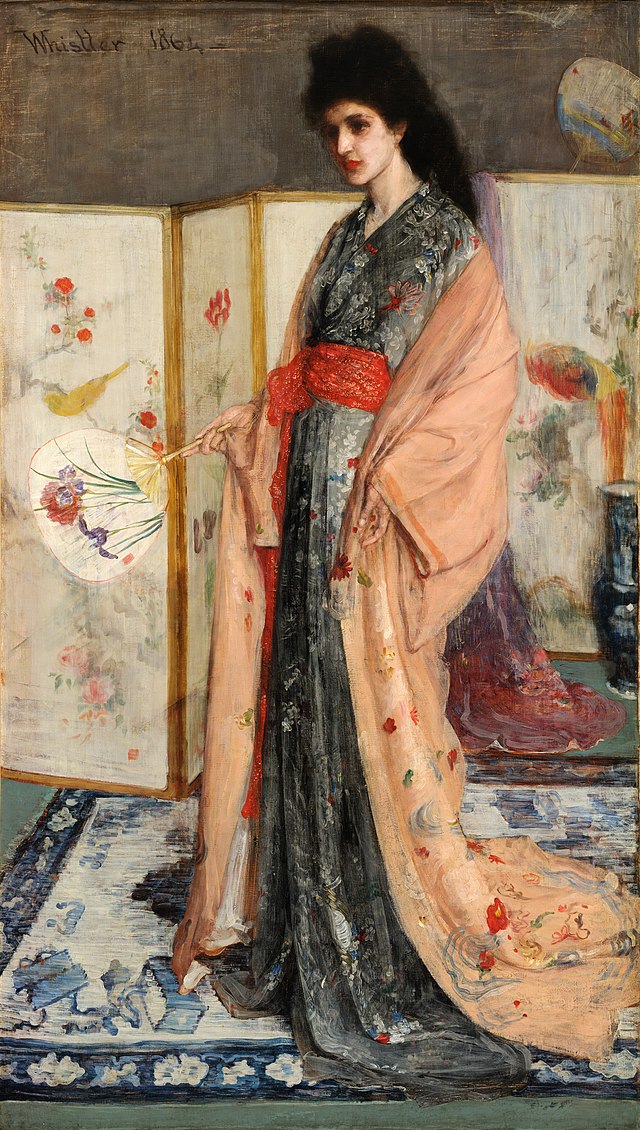In the mid 1850s, Japan opened its doors. Isolationism ended. Once more the country began to trade, entering again into global culture. And so, suddenly a great wave of Japanese art flooded into Europe and especially into France. Japanese articles such as silks, fans, kimonos, ceramics, and parasols began to circulate. Eventually, woodcut prints within a school of art called ukiyo-e became more and more common and began to interest Impressionist artists. Figures such as Claude Monet, Edgar Degas, Mary Cassatt, and Edouard Manet admired and studied these prints along with other Japanese objects and subsequently began to imitate and reference them in their own work. A new movement emerged: Japonisme, European art that demonstrated heavy Japanese influence.
Japanese objects began to appear within Impressionistic paintings and artists attempted to imitate Japanese techniques. Most interestingly, key stylistic features of ukiyo-e emerged within Impressionistic painting. Many Japanese prints utilized asymmetry, aerial perspective, bright color, and prominent contour lines. Impressionist artists began to incorporate these features into their own work, breaking from traditional European perspective and technique. Moreover, Japanese art in the mid 1850s focused upon portraying the ordinary, the mundane. French artists observed this practice and attached themselves to it. Impressionism had already begun to depart from traditional European subject matter. The influence of Japan only expedited the process. No longer did artists content themselves with history painting or commissions. Instead, they painted scenes of everyday life. Ultimately, the influx of Japanese art into France spurred artists to shy away from portraying scenes of grandiose nature and to instead capture glimpses of everyday life in unique perspectives.
Camille Pissaro, Jeanne Holding A Fan, c. 1873, oil on canvas, The Ashmolean Museum, University of Oxford
This piece portrays a little girl in a blue frock sitting, hunched, in a chair while holding a paper fan. She is positioned just off center, looking directly out at the viewer, her fan drooping dejectedly. At first, we might question how a work such as this could be influenced by Japanese art. Then we recognize Jeanne's fan. Pissaro includes a portrayal of actual Japanese subject matter. Without Japan's decision to end its isolationism, there would be no way for a little French girl to possess such an object.
This artwork features a tall woman wearing a kimono, holding another Japanese fan, standing in front of a Japanese screen. It is even more Japanese in its subject matter than Jeanne Holding a Fan. In this painting we see not only the heightened presence of Japanese objects in Europe, but also the French fascination with them. The woman pictured stands in a room literally filled with Japanese art. Through her we see France's captivation with the flowing fabric, the fashion, and the flowery and patterned instruments of the Japanese.
Mary Cassatt, Maternal Caress, 1890-91, drypoint, aquatint and soft ground etching; printed in color from three plates; sixth state of six, Accession number: 16.2.5
Not only did Impressionist artists depict objects from Japan, they also experimented with Japanese methods. In this work, Cassatt imitates the actual process of ukiyo-e woodblock printing, using a method called aquatint. Maternal Caress features flat planes of color and defined contour lines, making it very formally similar to many ukiyo-e prints. Additionally, we begin to see the artist's focus shift to the mundane. This mother and her child are not famous historically or popularly. They are ordinary people engaged in ordinary tasks.
Vincent van Gogh, La Berceuse (Woman Rocking a Cradle; Augustine-Alix Pellicot Roulin, 1851–1930), 1889, oil on canvas, Accession Number: 1996.435
La Berceuse also pictures an ordinary woman, a mundane figure rather than an incredible one. In this work, we see more traditional European technique overlap with Japanese technique. This is not a print, but oil on canvas, so it was not made in the same way a Japanese ukiyo-e would have been. However, it still uses heavy line, flat expanses of color, patterns, and aerial perspective as the prints would. Instead of light and dark creating depth, line gives us a sense of form. Instead of delicate layers of color, flat expanses of solid green, teal and red greet our eyes.
Monet's painting portrays a lovely terrace on the edge of the ocean. Several fashionable figures enjoy the sunny day while colorful flowers bloom brightly around them and two crisp flags wave above. Japanese influence might not seem as obvious in this painting. There are no crisp contour lines or distinctly Japanese subjects. However, color is blocked in a way that reminisces woodblock printing and the perspective is distinctly Japanese. In fact, Monet's painting seems to directly reference one specific print: Katsushika Hokusai's The Sazoido of Gohyaku Rakan-Ji Temple. Both images show a terrace with figures gazing out over a body of water. The perspective of the viewer is almost the same in both: slightly from above and looking down into the scene. And once more, this is not a history painting or a portrayal of famous persons. Rather, it is an ordinary moment.
Edouard Manet, Boating, oil on canvas, 1874, Accession Number: 29.100.115
This final work also utilizes a cropped perspective. The viewer seems to be standing behind a vehicle, the back wheels of a carriage obscuring the bottom right corner of the piece. Furthermore, Degas's painting also references a specific Japanese print: Utagawa Hiroshige's The Ushimachi Quarter in Takanawa from "One Hundred Views of Famous Places in Edo." But Degas's work, while from a Japanese work, is even less an imitation of it than Manet's Boating or Monet's Garden. For instance, there are even fewer contour lines and the use of colour is more nuanced. Instead, it is an example of the attitude at which Impressionists eventually arrived in their exploration of Japanese art. Japonisme did not copy Japanese prints. It used loose brushwork and oil paint, not woodblock printing. Instead, it ultimately borrowed specific stylistic elements of woodblock art in order to more interestingly convey impressions of the beautiful, mundane world.




No comments:
Post a Comment